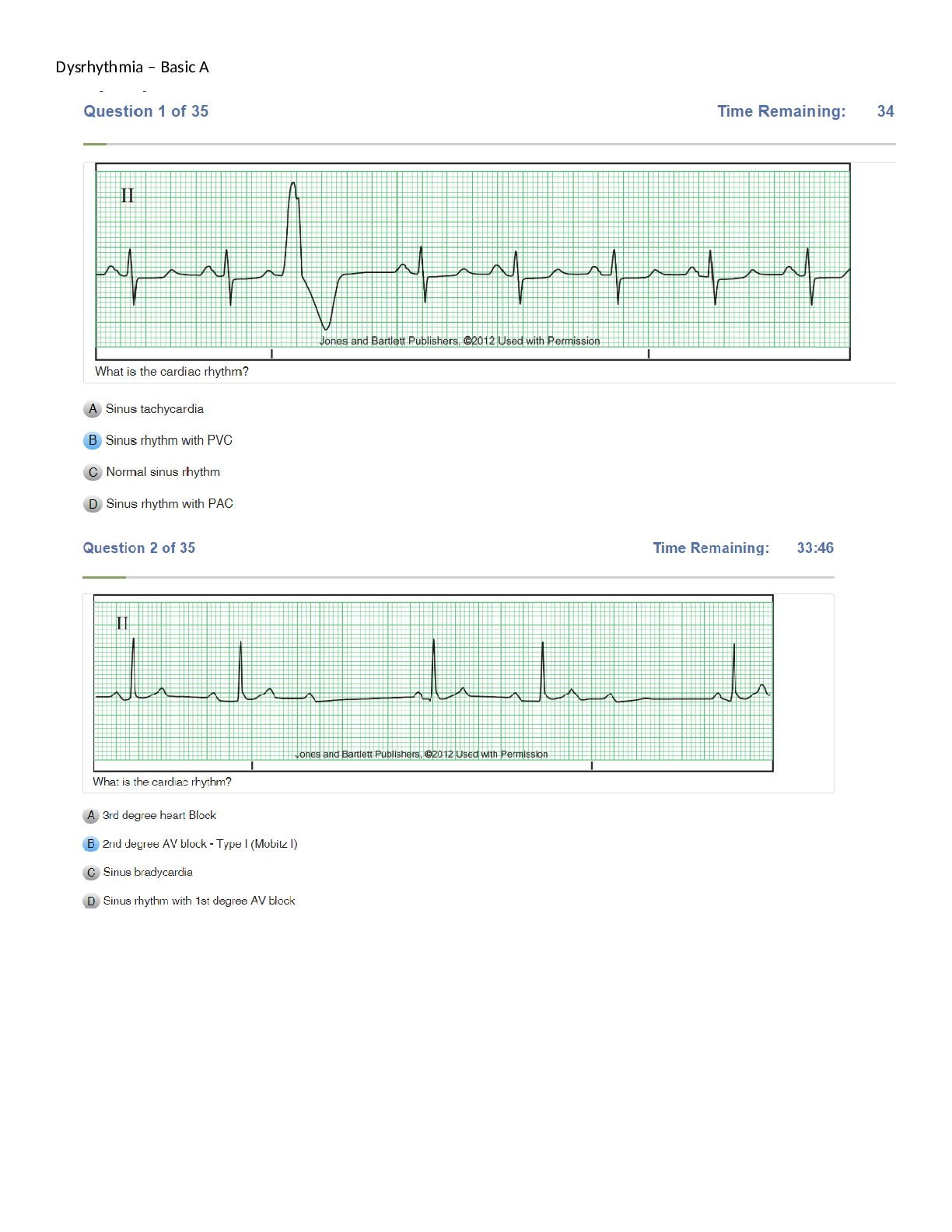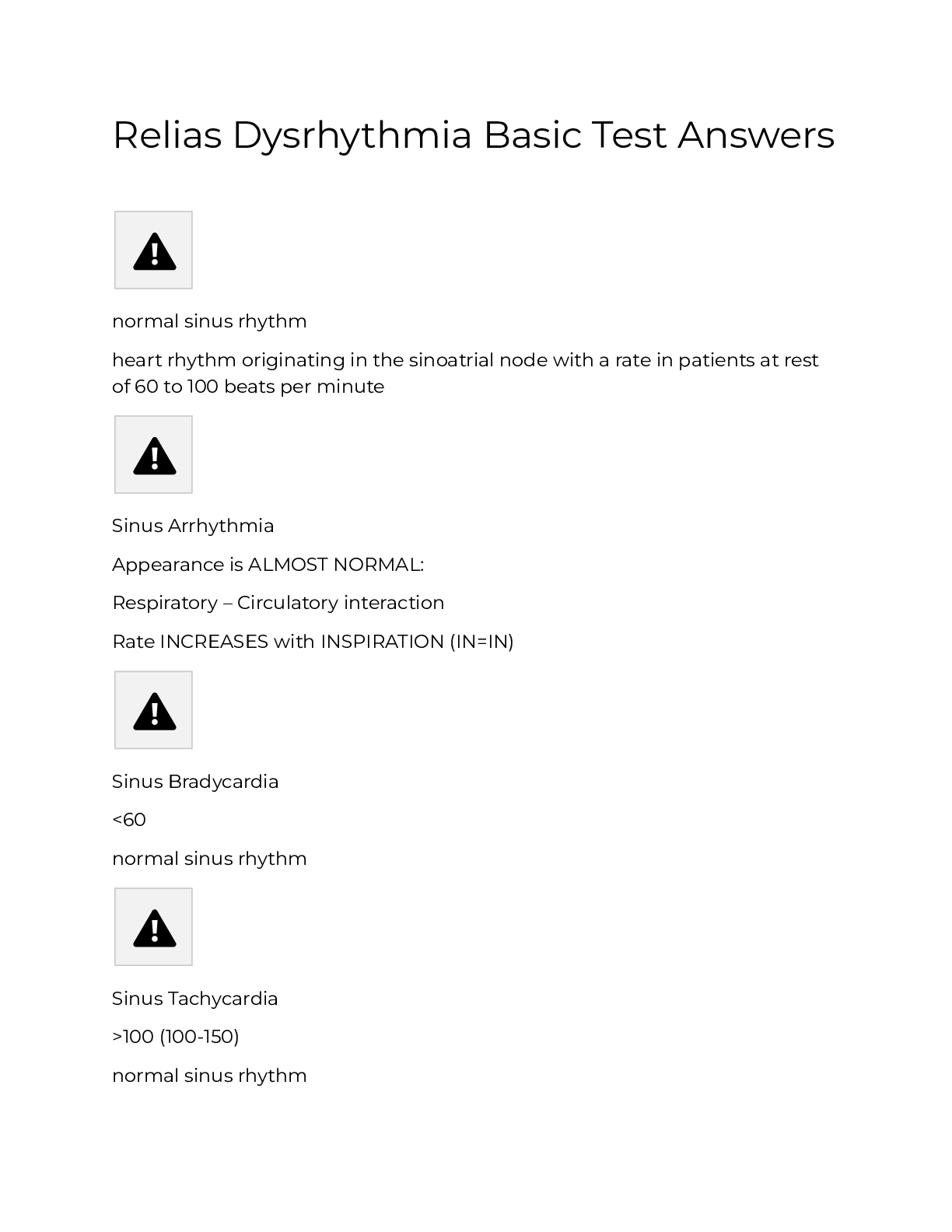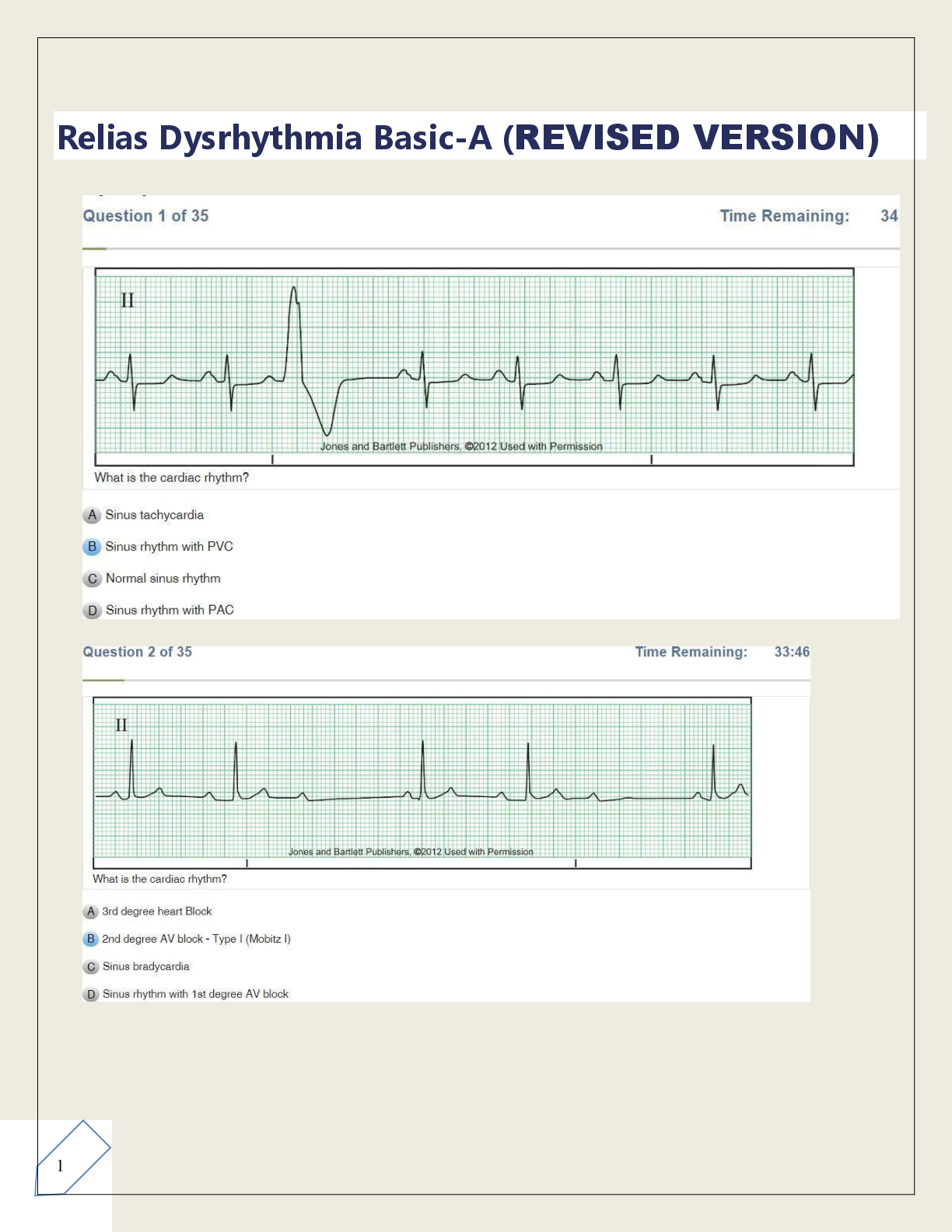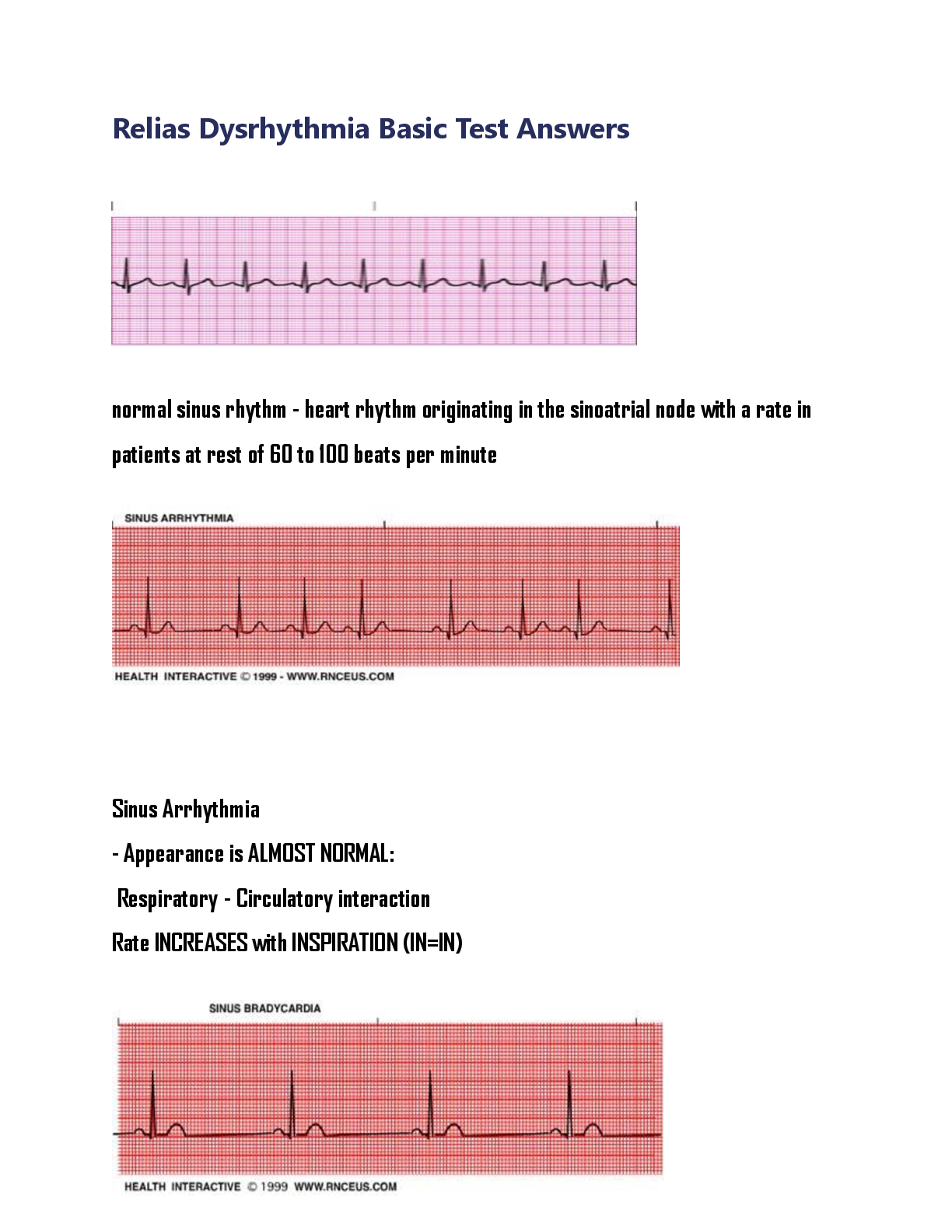Biology > QUESTIONS and ANSWERS > Relias Dysrhythmia Basic Test Answers Solution guide 2023. (All)
Relias Dysrhythmia Basic Test Answers Solution guide 2023.
Document Content and Description Below
Relias Dysrhythmia Basic Test Answers normal sinus rhythm heart rhythm originating in the sinoatrial node with a rate in patients at rest of 60 to 100 beats per minute Sinus Arrhythmia Appearance is A... LMOST NORMAL: Respiratory – Circulatory interaction Rate INCREASES with INSPIRATION (IN=IN) Sinus Bradycardia <60 normal sinus rhythm Sinus Tachycardia >100 (100-150) normal sinus rhythm Premature Atrial Contraction (PAC) Heart Rate: Depends on underlying rhythm Regularity: Interrupts the regularity of underlying rhythm P-Wave: can be flattened, notched, or unusual. May be hidden within the T wave PRI: measures between .12-.20 seconds and can be prolonged; can be different from other complexes QRS: <.12 seconds Sinus Arrest/Pause – SA node doesn’t fire – notice absence of P-wave for a complete cycle (a missed cycle) length of pause ≠ multiple of normal rate (block) Atrial Fibrillation (A-Fib) an irregular and often very fast heart rate originating from abnormal conduction in the atria Atrial Flutter irregular beating of the atria; often described as “a-flutter with 2 to 1 block or 3 to 1 block” Junctional Rhythm 40-60 Regular! -impulse from AV node w/ retro/antegrade transmission – P wave often inverted/buried/follow QRS – slow rate – narrow QRS (not wide like ventricular) Junctional Tachycardia >60 bpm (ms. K; 150-250) – KEY: will be regular (consistent) – AV junction produces a rapid sequence of QRS-T cycles – p-wave often inverted/buried/follow QRS Premature Junctional Contraction Inverted p wave or hidden p wave PRI<0.12 or none Normal QRS Supraventricular Tachycardia (SVT) an abnormal heart rhythm arising from aberrant electrical activity in the heart; originates at or above the AV node First degree heart block atrioventricular (AV) block in which the atrial electrical impulses are delayed by a fraction of a second before being conducted to the ventricles 2nd degree heart block type 1 (Wenkebach) Progressively longer PR interval until the P wave is not followed by a QPR 2nd Degree Heart Block (Mobitz II) Rare, but more serious Sudden appearance of a nonconducted P-wave P-waves are nl, but some aren’t followed by a QRS complex PR & RR intervals are constant 3rd degree heart block no obvious correlation between p and qrs, need pace maker premature ventricular contraction (PVC) a ventricular contraction preceding the normal impulse initiated by the SA node (pacemaker) Bigeminy PVC every other beat is a PVC PVC couplets PVC occurring in pairs, no adequate C.O. when this occurs monomorphic ventricular tachycardia presents with wide QRS complexes of a common shape. Torsades de pointes Rate: 120 – 200 usually P wave: Obscured by ventricular waves QRS: Wide QRS – “Twisting of the Points” Conduction: Ventricular only Rhythm: Slightly irregular Ventricular fibrillation (V-fib) abnormal heart rhythm which results in quivering of ventricles Idioventricular Rhythm <40 *looks like vtach but slow* – no P waves (from vent foci) – Wide QRS (serious, death like rhythm) – called “dying heart” rhythm…occasional ventric beat b4 death (asystole) Accelerated Idioventricular Rhythm Rate: 50 – 100 usually (usually slow) P wave: Obscured by ventricular waves (occur during ventricular contraction) – SA node slower than faster ventricular pacing than should be QRS: Wide QRS Conduction: Ventricular only Rhythm: Regular- benign rhythm that is sometimes seen during acute MI or early after reperfusion. – Rarely sustained, does not progress to vfib, rarely requires treatment asystole absence of contractions of the heart Failure to capture (pacemaker) failure to sense (pacemaker) Atrial paced rhythm spike before P wave Ventricular paced rhythm ventricular contractions which occur in cases of complete heart block. Normal sinus rhythm Regular Rate: 60-100 P Wave: Present, upright PR Interval: 0.12-0.20 sec QRS: <0.12 sec Sinus Bradycardia Regular Rate: <60 P Wave: Present, upright PR Interval: 0.12-0.20 sec QRS: <0.12 sec Sinus Tachycardia Regular Rate: 100-150 P Wave: Present, upright PR Interval: 0.12-0.20 sec QRS: <0.12 sec Premature Atrial Contraction IRREGULAR Rate: depends on underlying rhythm P wave: Present or hidden in T wave PR Interval: 0.12-0.20 sec QRS: <0.12 sec Atrial Fibrillation IRREGULAR Atrial rate: UNMEASURABLE Ventricular rate: variable P wave: unable to see PR Interval: N/A QRS: <0.12 sec A fib RVR IRREGULAR Ventricular rate: 100-175 P wave: unable to see PR Interval: N/A QRS <0.12 sec Atrial Flutter Usually REGULAR can be irregular Atrial rate: 250-350 Ventricular rate: variable BUT < atrial rate P Wave: Flutter PR Interval: N/A QRS: <0.12 sec Supraventricular Tachycardia Regular Rate: 150-350 P wave: Hidden in QRS or T wave PR: unable to determine QRS: <0.12 sec Junctional Rhythm Regular Rate: 40-60 P Wave: ABSENT or INVERTED PR Interval: None or <0.12 QRS: <0.12 sec Accelerated Junctional Rhythm Regular Rate: 60-100 P Wave: NONE or INVERTED PR Interval: None or <0.12 QRS: <0.12 sec Junctional Tachycardia Regular Rate: >100 P Wave: NONE or INVERTED PR Interval: None or <0.12 QRS: <0.12 sec Premature Ventricular Contraction IRREGULAR Rate: refer to underlying rhythm P Wave: NONE PR Interval: N/A QRS: WIDE and BIZARRE , >0.12 sec Ventricular Tachycardia Regular Rate: >100 P Wave: NONE PR Interval: N/A QRS: WIDE and BIZARRE, >0.12 sec Ventricular Fibrillation Chaotic Coarse: big waves Fine: small waves Rate: unmeasurable P Wave: NONE PR Interval: N/A QRS: N/A Idioventricular Regular Rate: 20-50 P wave: NONE PR Interval: N/A QRS: WIDE, >0.12 sec Accelerated Idoventricular Rhythm Regular Rate: 50-100 P wave: NONE PR Interval: N/A QRS: WIDE, >0.12 sec 1st Degree AV Block Regular Rate: 60-100 P Wave: Present, upright PR interval: >0.20 sec CONSISTENTLY LONG QRS: <0.12 secHusband stays late till 9 consistently 2nd Degree AV Block Type I Mobitz, Wenckebach IRREGULAR Rate: 60-100 P wave: Present, upright PR Interval: Progressively longer until drop (PR interval longer and longer until drop) QRS: <0.12 secHusband stays late till 9, then 11, then 1, then doesn’t come home at all 2nd Degree AV Block Type II Irregular or regular Rate: <60 P wave: Present, upright PR Interval: PR interval consistently LONGER like type 1 but then a QRS will drop QRS: <0.12 secHusband stays late till 9 consistently, then wife goes out and doesn’t come home 3rd Degree AV Block Atrials and ventricles don’t communicate Rate: regular atrial P wave: Present, upright No relationship between P waves and QRS PR Interval: VARIABLE QRS: variableP-P ad R-R consistent but NO correlationHusband and wife live separate lives and don’t communicate SA Node 1st 60-100 AV Node 2nd 40-60 Bundle of His 3rd 40-45 Right and Left Bundle Branches 4th 40-45 Purkinje Fibers 5th 20-50 1 Small Box 0.04 sec 1 Big Box 0.20 sec Junctional Rhythms SA Node DID NOT FIRE AV Node fired NO P WAVE bc SA node didn’t fire Narrow QRS P Wave Amplitude 0.5-2.5 mm Will be shorter than T wave Shows firing of SA node QRS 0.06-0.10 sec SHOULD BE <0.12 sec Wide QRS: delay in ventricular contraction, delay of conduction through bundle branches or purkinje fibers BUNDLE BRANCH BLOCK or BLOCK IN PURKINJE FIBERS (idioventricular) Calculate Regular Rate 1500/ # boxes R-R Calculate Irregular Rate # of Rs in 6 sec strip X 10 Unifocal PVCs Only 1 shape PVC Bigeminy PVC occurs every OTHER beat Trigeminy PVC occurs every THIRD beat Couplet 2 PVCs together Triplet 3 PVCs together Multifocal Multiple shapes Monomorphic V Tach Same Shapes V Tach Polymorphic V Tach Different Shapes V tach Coarse V Fib Chopy but not as high as polymorphic V tach Fine V Fib Fine and fibrillatory Idioventricular Rhythms Only purkinje fibers firing WIDE QRS always Atrially Paced Spike comes before P Ventricularly Paced Spike comes before QRS and QRS will be wide AV Paced Spike before P and before QR Failure to Capture Spikes with no QRS Failure to Sense Spikes happen regardless of QRS on their own How to determine the rhythm Regular or irregular? Rate? P before every QRS? QRS for every P? QRS wide or narrow? QT Interval 0.34-0.43 P Wave 0.06-0.12 sec PR Interval 0.12-0.20 sec SA Node Firing Rhythms *Fires normally @ 60-100* -SR 60-100 -SB <60 -ST 100-150 -SVT 150-350 AV Node Firing, SA Node Failed Rhythms *Fires normally @ 40-60* -Junctional rhythm 40-60 -Accelerated junctional rhythm 60-100 -Junctional tachycardia 100-150 Only Purkinje Fibers Firing Rhythms (Everything else has failed) *Fires normally @ 20-50* -Idioventricular 20-50 -Accelerated idioventricular 50-100 [Show More]
Last updated: 2 years ago
Preview 1 out of 2 pages
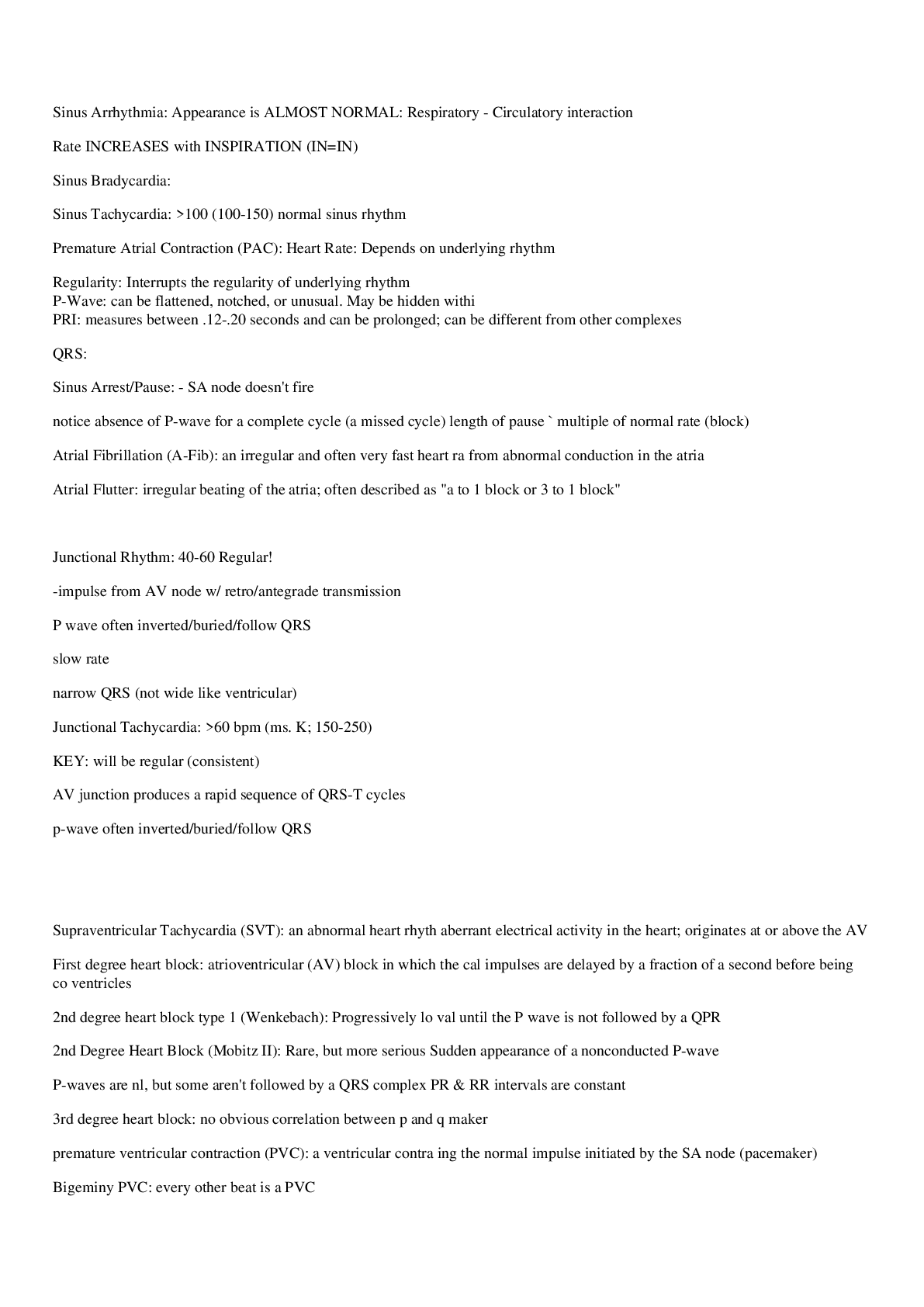
Buy this document to get the full access instantly
Instant Download Access after purchase
Buy NowInstant download
We Accept:

Reviews( 0 )
$5.00
Can't find what you want? Try our AI powered Search
Document information
Connected school, study & course
About the document
Uploaded On
Apr 02, 2023
Number of pages
2
Written in
Additional information
This document has been written for:
Uploaded
Apr 02, 2023
Downloads
0
Views
214

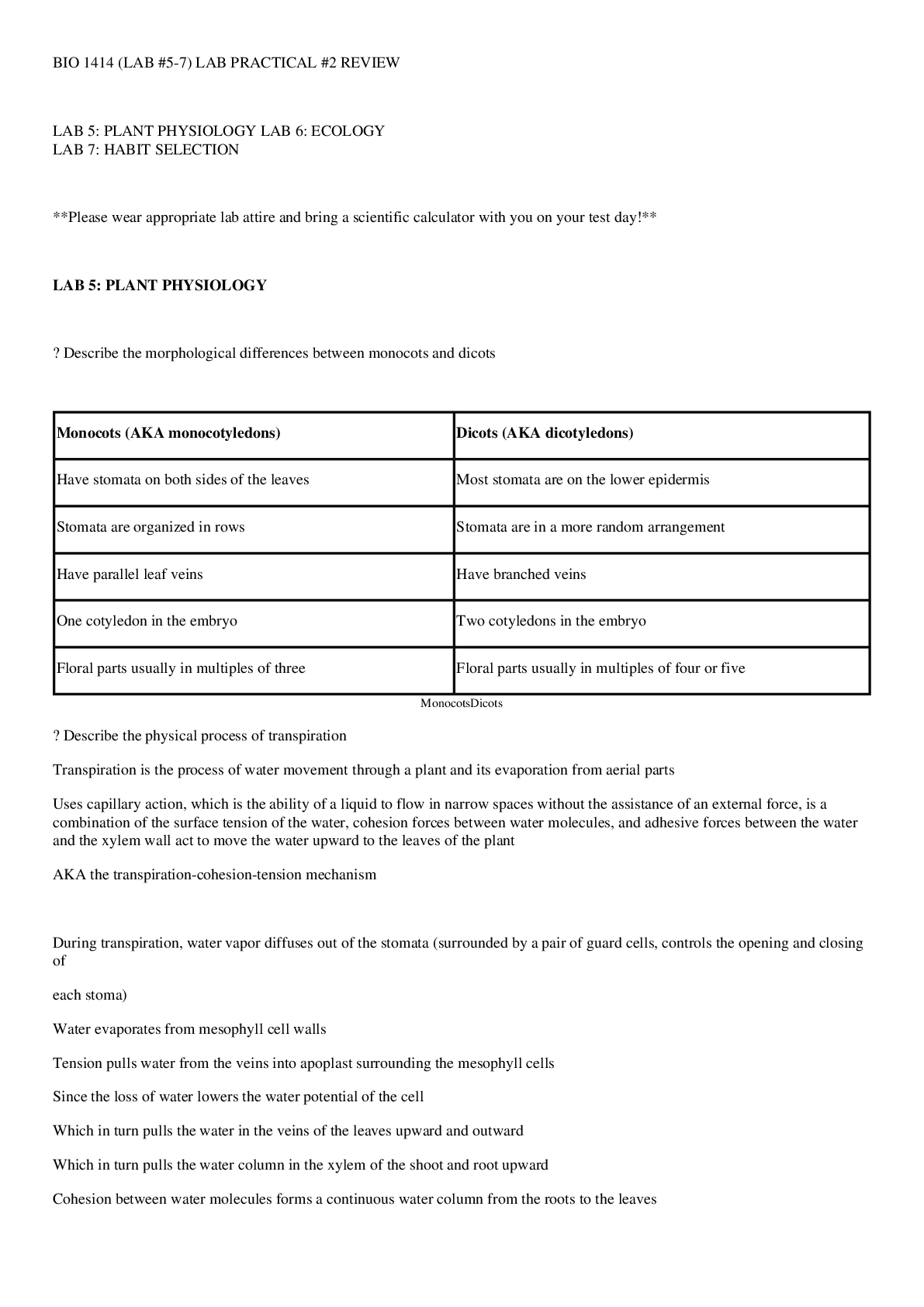
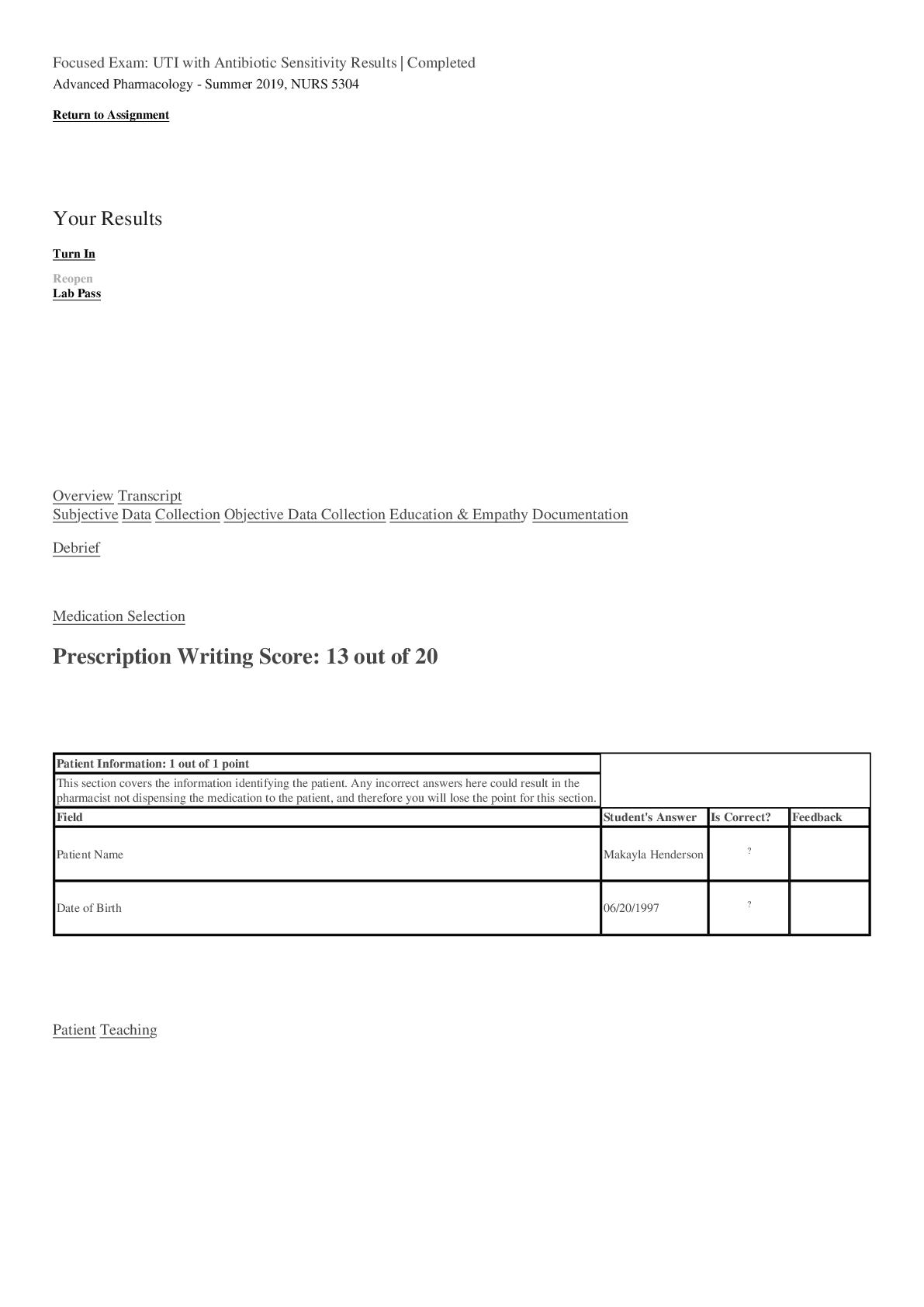

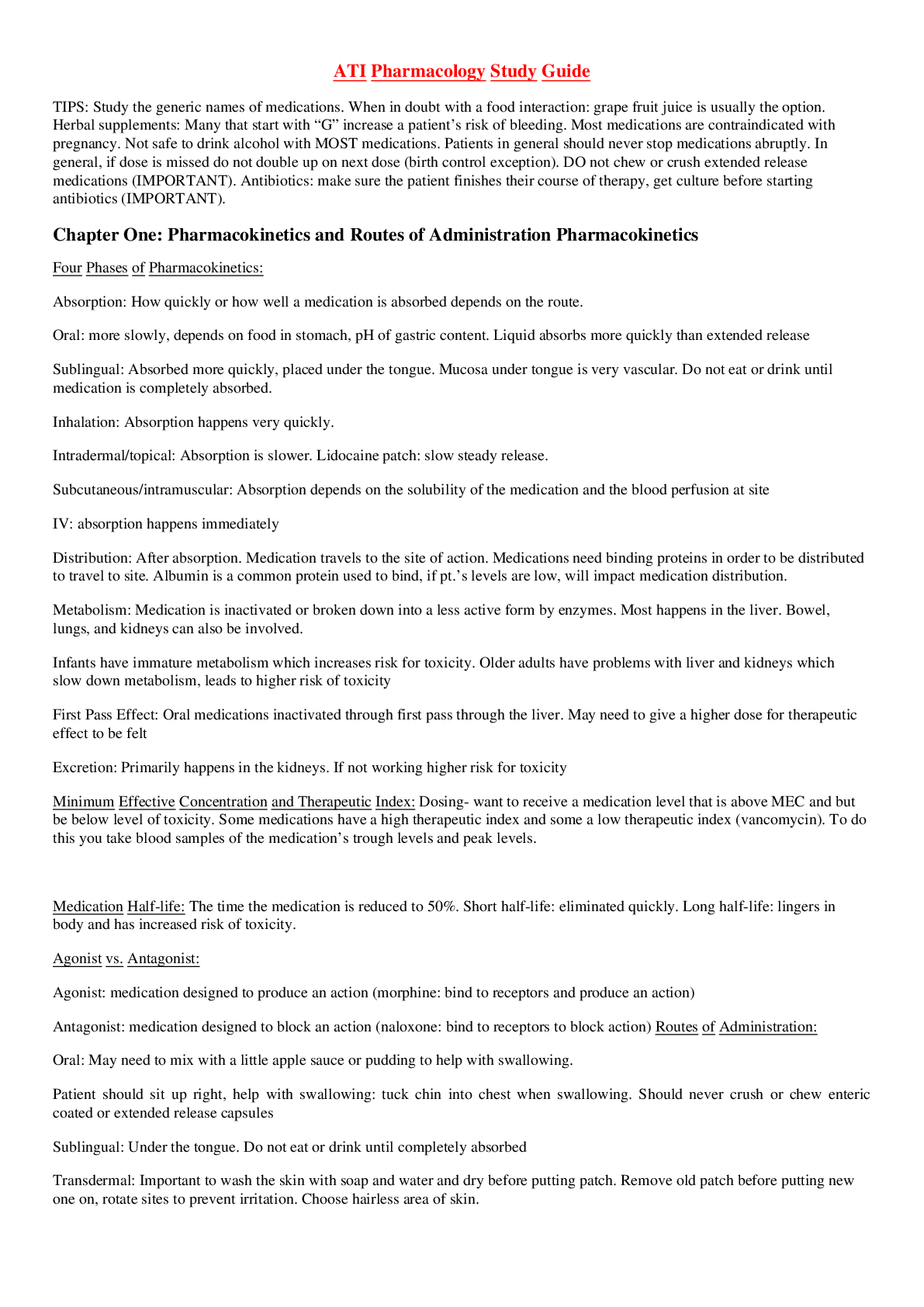
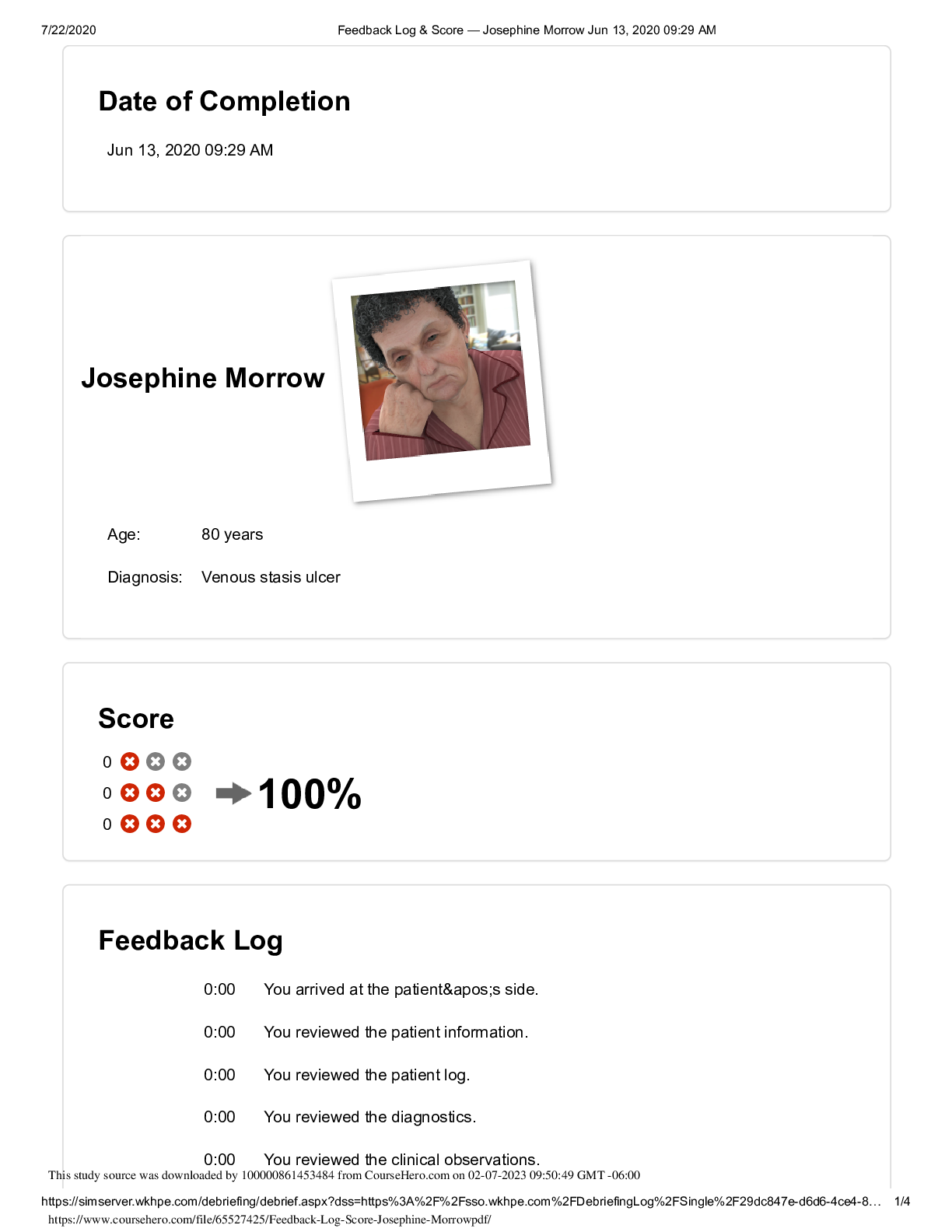
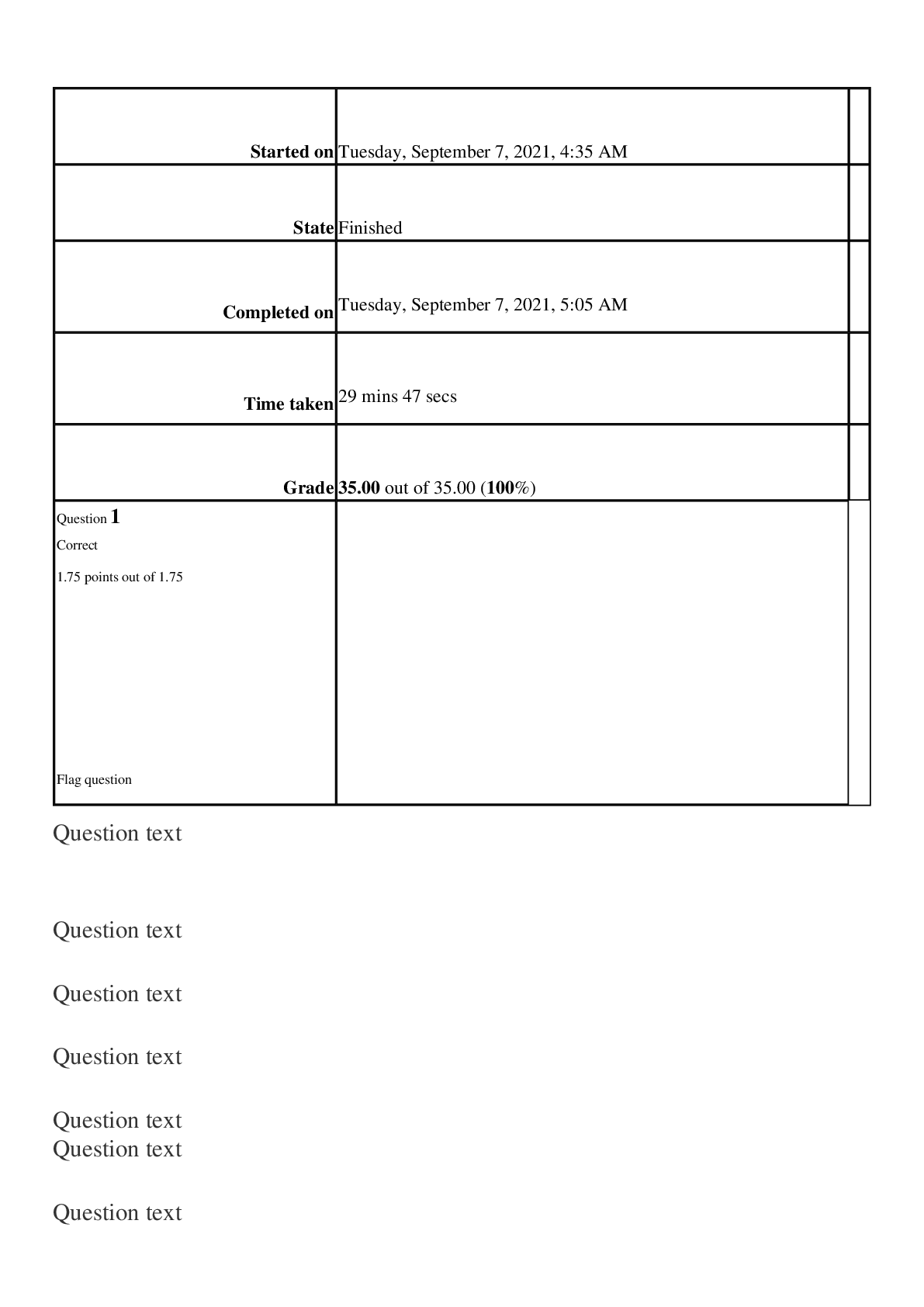


.png)

.png)

